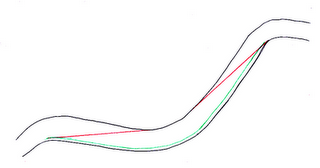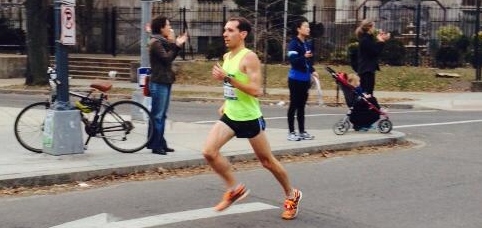Tune-up races are tough – especially before a marathon. So I’m psyched about my race at this year’s Rock ‘n’ Roll Half Marathon in Washington, DC.
With five weeks to go before the Boston Marathon, I’m deep in the midst of training: 80+ mile weeks, grueling long runs, and workouts that seem to go on for hours. Actually, they do go on for hours…
And with no taper or half marathon-specific workouts, racing a half right now is difficult. You’re tired, under-rested, and have no turnover in your legs from all the heavy training.
But despite all that, half marathons have become a staple tune-up race 3-5 weeks before a marathon goal race. I wrote this awhile back about HM tune-ups:
Marathoners should race a half marathon before a marathon only if they’re already in very good shape, injury-free, and know they can recover enough in 2-3 days to resume normal training. If you tend to recover more slowly or know your body can’t handle the demands of a half, choose a shorter tune-up race like 10k or 10 miles.
Boy, am I feeling that half in my legs right now! Even though I’m in great shape, it hurts to walk down stairs and my run the day after the race was significantly slower than usual.
But regardless, it was a fantastic experience and leaves me very encouraged for the Boston Marathon next month. I ran 74:05 and finished in 16th place out of 16,724 half marathon finishers. My splits:
- 5k: 17:39
- 10k: 35:24
- 10mi: 56:44
- Overall Pace: 5:40
You can check out my full results here.
Today I want to share my insights, lessons, and observations from the race so you can learn from them and hopefully race faster. Some might be obvious, a few humorous, and all of them can help race day go smoother for you.
Stop Standing Around So Much!
On Friday I went to the Rock ‘n’ Roll Expo to pick up my bib, get my gear check bag, and score some free snacks from the many vendors exhibiting at the DC Armory. Even with security, filling out a medical form, standing in two more lines, and a quick lap around the entire Expo, I was finished in less than 30 minutes.
But I noticed most runners were just hanging out, standing up for awhile at each vendor and wasting time on their feet. The same was true immediately before the race when thousands of runners were talking to one another near the gear check trucks.
My college coach has a great piece of advice for marathoners that every runner should heed:
Don’t spend a lot of time at the Expo – get your number, see a few vendors, but get out of there as soon as possible.
The last thing you need is to spend hours on your feet before a major race, accumulating fatigue when you should be resting. Whenever possible, sit down and relax.
This may seem trivial, but you’ve spent months preparing. Why let a few hours of being on your feet put your race at risk?
No Warm-up? Coach Jason Angry!
Before the race started, I saw only a handful of runners doing any type dynamic warm-up. Most were standing around, doing a few static stretches – which is the WORST way to get ready for a race.
In an interesting observation, I saw that the handful of runners who were doing a dynamic warm-up were the faster runners. Before you say, “yeah, that’s because they’re fast!” I’ll ask you this:
Do these runners do dynamic stretches because they’re fast? Or are they fast because they do “extras” like a dynamic warm-up?
Noodle on that.
There Are Less Crowded Bathrooms Nearby
At any big race, there are going to be huge lines for the porta-potties. Except the 2008 NYC Marathon, when there were hundreds of unused toilets lining the streets. It was my Graceland…
But if you’re smart, you can skip these lines entirely. Just start your warm-up and run to the nearest coffee shop. Within 7 minutes of running I found a Starbucks that had five open stalls. This works as long as you’re in a more urban area and it’s not too early in the morning.
#BOOM – no waiting in porta-potty lines!
Run the Tangents
I’ve been saying this for years, but I saw thousands of runners going the long way around turns and corners last weekend at the Rock ‘n’ Roll half. And with about 18 ninety-degree turns and many other less sharp turns through just the half marathon course, it becomes even more important.
Run tangents by not following the curve of the road and running the shortest distance between each turn, like the red line here:

Even though running the tangents means that you’ll expose yourself to the road’s camber, it’s worth it. You likely won’t hurt yourself this way after one race. The dangers of running on the camber are real, but it takes more than one run to develop muscle imbalances that can lead to injuries.
You Will Doubt Yourself
No matter how fast you are, you’ll doubt your ability. I couldn’t believe my own cowardice during the early miles of this race when I thought of dropping out because of my Achilles injury or slowing down because I wasn’t comfortable (like any race is supposed to be “comfortable?”).
Alberto Salazar – three-time winner of the New York City Marathon – once said:
I had as many doubts as everyone else. Standing on the starting line, we’re all cowards.
Race anxiety is normal. Doubt, fear, and stress will happen. What matters is that you overcome these feelings, believe in your preparation, and trust your training.
Any race should be a natural extension of your past training. It shouldn’t be a surprise – nor should it be a huge cause for worry if you’re well prepared.
Recovery Starts At the Finish Line
How many thousands of runners finished the RnR half last weekend, ran no warm-down, did no dynamic stretches of light exercises, and immediately went to the beer tent? My bet: way more than half.
While my marathon recovery process is more strict because of the damage inflicted by 26.2 miles, I take tune-up race recovery seriously because training must go on after the race. When I finished, I did this:
- Walked for 10 minutes and drank about 8oz of water (in hindsight, I should have had sports drink for the calories)
- Ran a warm-down at a very easy pace
- Ate a protein Powerbar and drank lots of sports drink and water
- Walked to the subway and immediately did the Myrtl Routine when I got home
- Ate a big meal and continued to hydrate all day
Unless the race is your goal race and you’re taking 1-2 weeks off (then it’s ok to throw these rules out the window!), remember that you have workouts coming up soon.
Your legs need all the help they can get!
Focus on the Process
Good runners always focus on the process of training: the delicate balance between hard work, recovery, and leading a healthy lifestyle that enhances your training.
And on race day, this process is no different. It usually goes like this:
Dynamic warm-up, run warm-up, strides, race, refuel, warm-down, refuel, core exercises, big meal, nap (extra credit!), and lots of sleep.
Everything before the race is planned to maximize performance. And everything after the race is planned to maximize recovery.
All work and no play makes Jack a dull boy… so Saturday evening I enjoyed a few adult beverages at the SR Meetup in DC and then afterward with a friend of mine. I’m not telling you to be a saint 🙂 Have some fun, too!
How Did You Race?

Last weekend was a big racing weekend across the country and I want to congratulate everyone who raced, particularly my runners Marcie, Sarah, Jim, Charis, Danni, Nika, Linda, Danielle, and Nicole. Nice work everyone!
And to all those I spoke to who ran the Rock ‘n’ Roll Half Marathon and Marathon – John, Dorothy, Jamie, and Craig – it was a great day to race in DC!
How about you – did you race last weekend? How’d it go?
Any sticking points I can help with? Leave a question below and I’ll try to reply to every one.